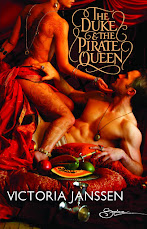#
Roll Your Own
One of the biggest issues with writing any paranormal beastie is the need to bring something new to the table. With everybody writing about vampires these days, why should someone want to read about yours? Let's say you want to make your vampires stand out from the pack by being different from your everyday Count Dracula stereotype. Where do you start?

Well, there are lots of cultures out there with their own versions of vampires (one of my favorites is the Bulgarian vamp, which has only one nostril). You can add a lot of originality to your work by just exploring new (to you) folklore.
But what if you don't want to go the Western vamp route or the "borrowing from elsewhere" route? What if you want to make something all your own?
So let's say you want to make up something new and shiny. Problem number one with that is: If you make up something that has nothing in common with a vampire, what makes it a vampire? Why isn't it called a Thubmert?
(The secret answer to this is, there is no reason why you can't call something a vampire. "Vampire" is just a word we made up. Maybe in other universes, "vampires" are what people call post-it notes. You're an author; you can use whatever words you like. But authors don't write in a vacuum, and eventually you're going to have to do a major bit of hand-waving to get your reading audience to follow along with those sorts of shenanigans.)
Let's say that if you want to call something a vampire, you need some recognizable vampiric traits to build off on. Right off the top of my head, I can think of: Dead, drinks blood, pointy teeth, drive to create more vampires, can't go in sunlight, a stake through the heart kills them.
The next step is to twist these traits around -- make them mean different things, or take them a step further than tradition normally does. Some examples:
- This Dinosaur Comic makes an excellent example of the "taking extremes" method by categorizing most vampiric traits as just OCD, thereby letting people easily "deduce NEW vampire facts and weaknesses!"
- Stephanie Meyer's took the idea of "vampires can't go out in sunlight" and changed it from "because they burn!" to "because they sparkle and will reveal their true nature" -- while the sparkling thing is dopey, that's a pretty neat turn on the folklore. The basic fact stays the same, but the reason for it changes.
- Doctor Who's "Vampires in Venice" episode has vampires that don't really have pointy teeth, even though they appear to -- they're an illusion supplied by the human brain, to attempt to give some kind of warning of their being predators.
- Scott Westerfeld talks about the process of boiling down vampiric traits for his excellent vampire novel Peeps, taking on the sexual aspects as well as the unnerving reasons why vamps might want to create more vamps.
- And in my own book, Salt and Silver, vampires can suck blood... through their butterfly-like proboscis. When I first created these vamps, all the other demons in my world were insect-like, so I wanted to continue the theme. It wasn't until later that I discovered that Filipino folklore had butterfly-vampires. So I ran with it, and now, as I write the sequel (starring the vampires front-and-center), I'm trying to bring a little more juice to the creative processes. One of the driving principles of my worldbuilding is that to have a part of someone is to know them utterly. In the first book, true names were things to keep out of bad guys' hands -- but blood is just as much a part of someone as their name. So what does drinking blood do, if even a tiny sip can give you a world of knowledge?
Ladies and gents: My vampires are academics.
Keeping vampires (or other mythological creatures) fresh -- but familiar -- is a tough row to hoe, but you'll be amazed by what you can come up with using a twist of thought and a little reductio ad absurdum logic. Have fun!
Note: I can't recommend enough the use of motif indexes for writing research (mine's the Stith Thompson Motif-Index of Folk-Literature, but others include Aarne's The Types of the Folktale and Uther's recent The Types of International Folktales). Vampires are tale type E251: "Vampire: Corpse which comes from grave at night and sucks blood", but there are a ton of little details and stories to follow up on in there.
#
Thanks so much!




No comments:
Post a Comment